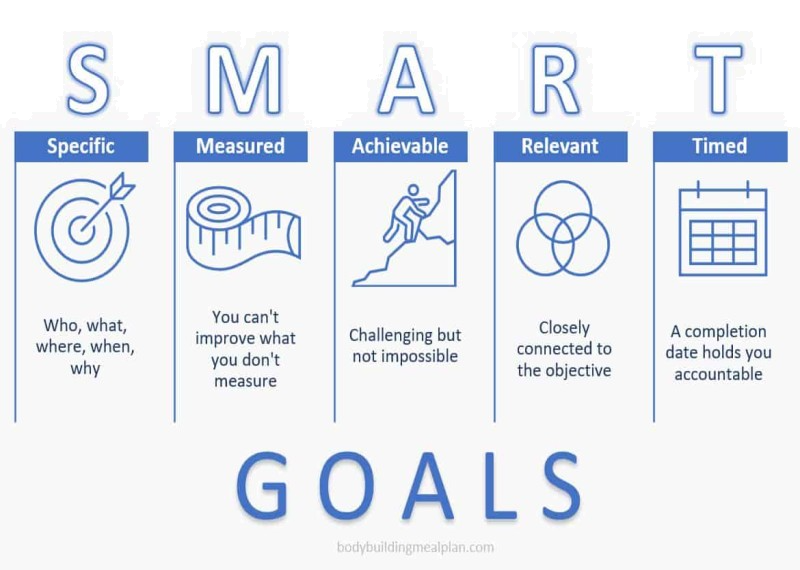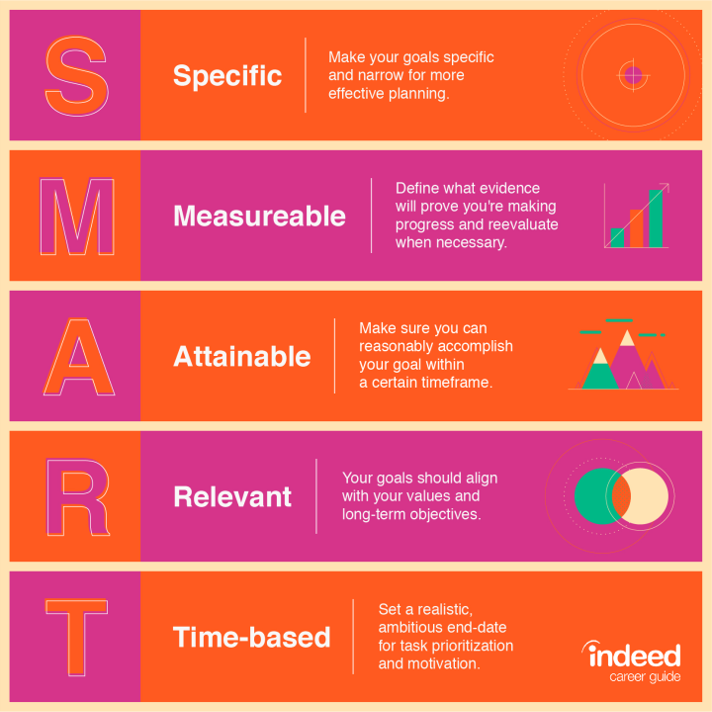How to set SMART goals?

When setting specific marketing objectives to support your long-term goals, it is good practice to use the widely used SMART objectives. SMART is used to assess the suitability of different strategies or targets for improving the whole range of business processes.
What are SMART goals?
SMART is an acronym used to describe the process of setting goals. The acronym stands for the words “specific,” “measurable,” “achievable,” “relevant” and “time-bound,” which are essential traits of setting objectives. The SMART method provides a way to measure your progress and be accountable for your success. Setting SMART goals allow you to realistically evaluate what you are trying to achieve by assessing what actions to take to reach your goal.
For example, you might set a goal to “get better” at typing. However, upon evaluating this goal using the SMART method, you see that your goal is quite vague. By restating your goal in quantifiable terms, such as “be able to type more words per minute,” you have a SMART goal that can be obtained. The characteristics of this goal can then be further detailed to reflect the remaining traits of the SMART goal process.

How to set SMART goals
When you decide to set a goal for yourself, consider following the SMART steps to help you achieve your objectives:
- Make your goal specific.
- Make your goal measurable.
- Make your goal achievable.
- Make sure it is relevant.
- Create a time-bound schedule.
1. Make your goal specific.
The first step in creating an attainable goal is to get specific with how you describe it. Consider it in quantifiable terms and determine what actions you need to get there. The examples below show how you can fine-tune a broad objective into a specific SMART goal.
Example goal before “specific” criteria: “I want to get better at typing.”
Example goal after “specific” criteria: “I want to increase my typing speed.”
This example goal takes a broad statement that could present different approaches and actions—like learning the proper typing techniques or not having to look at the keyboard while typing—and makes it more specific by evaluating which aspect of typing can be set as a goal. This example can then be further evaluated to check that it fits the remaining criteria of a SMART goal.
2. Make your goal measurable
After setting your specific goal, it is time to evaluate how you will take action to measure it. This step in the SMART process prompts you to apply methods of measuring your progress toward achieving your goal. Being measurable also takes into account any actions you would implement to help you further your progress toward your goal. For instance, this may take the form of tracking the time it takes you to complete an action or meet a milestone. The following example shows the evolution of a broad goal into a specific and measurable one.
Example goal before “measurable” criteria: “I will increase my typing speed.”
Example goal after “measurable” criteria: “I would like to increase my typing speed from 50 words per minute to 65 words per minute, and I can measure my progress by taking timed tests that show the increase in my typing speed.”
3. Make your goal achievable
After writing a specific goal and evaluating how you will measure it, consider if your set objective how achievable it is. Considering how long it will take, potential obstacles, and measurement methods will all help you determine the realistic odds of achieving your set goal. The more realistic and achievable the goal, the more likely you will be to keep working toward it. Consider the following examples that illustrate a “before” and “after” effect when applying the “achievable” criteria to your goal.
Example goal before “achievable” criteria: “I will increase my typing speed of 50 words per minute to 100 words per minute.”
Example goal after “achievable” criteria: “I would like to increase my typing speed of 50 words per minute to 65 words per minute, and I can achieve this goal by making small increases in my typing speed each week.”
This aspect of the SMART strategy also relates to your goal being measurable. With a specific measurable goal, it is more likely to be achievable because it can allow you to see exactly how you will achieve your progress as you work toward the goal. While the example goal of reaching 100 words per minute could be achievable, when related to the rest of the SMART criteria, it could be that this goal will not be achievable in the time frame you scheduled, or that it will require more resources to get there.
4. Make sure it is relevant
When a goal is relevant, it relates directly to a skill or professional development strategy that you want to improve. For instance, if you wanted to receive a high mark on your next employee evaluation, it would make sense to set a goal to help you improve your skills and workflow to progress to that goal. Additionally, any milestones you set or actions you take to achieve your goal should directly influence your progress. The examples below show how the “relevant” trait is applied.
Example goal before “relevant” criteria: “I would like to increase my typing speed, so I will set aside 15 minutes every day to organize my workspace.”
Example goal after “relevant” criteria: “I would like to increase my typing speed from 50 words per minute to 65 words per minute, so I will set aside 15 minutes every day to practice my typing and take timed speed tests.”
This example highlights a relevant action that can be taken to help progress toward achieving the goal. Your goal and measurable actions should be all be coherently related.
5. Create a time-bound schedule
Time-bound refers to the timeline you set for working toward your goals as well as how long it will take you to meet milestones and achieve your final results. Consider if your goal is a short-term or long-term goal. From there, you can determine a timeline and set a schedule for yourself to meet deadlines and get to your objective. Your timeline should also be realistic and allow you plenty of opportunities to make adjustments to your goal regarding its relevance, specificity and attainability. Consider the final step in the SMART process in the following example.
Example goal before “time-bound” criteria: “I will increase my typing speed of 50 words per minute to 65 words per minute by setting aside 15 minutes every day to practice speed typing and take timed tests.”
Example goal after “time-bound” criteria: “I will increase my typing speed of 50 words per minute to 65 words per minute within three months. I will set aside 15 minutes each day to practice at speed and take timed tests weekly to measure my progress.”
This goal now fits all the criteria of a SMART goal because it shows how specific the objective is, outlines a way to measure progress, is achievable and relevant to the desired skill development and sets up a timeline for each milestone and overall completion of the goal.
